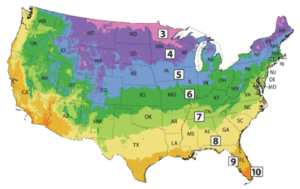How to design a cover crop mix for fall planting
Fall is the most common time to plant a cover crop but as the season changes, the ideal planting time for each plant species is going to shift as well. These planting time frames will influence how diverse or how simple a fall cover crop mix can be. Green Cover has a huge variety of species to choose from when making cover crop mixes and our team of sales representatives have the cumulative knowledge and experience to help walk you through the process of choosing the right mix for your planting window and your soil health goals.
Here are some basic guidelines for cover crop species planting windows based on the middle of the country, USDA plant hardiness zone 5a. These dates should be adjusted as you move north (subtract 1.5 – 2 weeks) or south (add 1.5 – 2 weeks).

August 1st – August 15th
Planting cover crops in August is the perfect time for maximum diversity as the majority of cover crop species found on our website can be used. There is enough summer heat to get good growth out of most of the warm season species yet the weather will cool down soon so partial rates of cool season species make sense as well. Full seeding rates of winter annuals like cereal rye and vetch should wait another couple weeks for best results.
August 15th – Sept. 15th
This time window is great for all cool season cover crop species. A few warm season species like buckwheat, sunflowers, safflower, grazing corn can still work but it is best to focus on cool season species as the calendar rolls into September. Excellent growth can be achieved by spring annuals like oats, peas, radish and turnips, but winter annuals can easily be added as well.
Sept. 15th – October 10th
No warm season species are recommended and spring annuals can be used but with the understanding that full growth potential may not be realized with an early winter. Excellent time for winter cereals along with peas and vetch. Cold hardy brassicas like rapeseed and camelina can still be used as well.
October 10th – November 1
Winter cereals like cereal rye and triticale work well along with hairy vetch. Winter peas could work on the early end of this window if they are planted deep to keep the growing point protected.
After November 1st
Cereal rye is by far the best option for this late planting as it will germinate in 34 degree soils and can photosynthesize in temperatures as low as 38 degrees. For these reasons, cereal rye can be planted even into early December in some years. Triticale and hairy vetch can be used in early November but fall growth will be very minimal and spring growth will be slower than what an earlier planting would afford.
Keep in mind that these are general guidelines and that these windows will vary from year to year with fall temperature and moisture. Please reach out to any of the Green Cover Sales Team if you have any questions or would like help in building the mix possible for your situation.
Want to talk with one of our expert sales representatives?
Fill out this form or give us a call today. 402-469-6784.